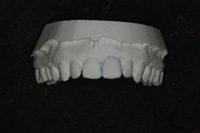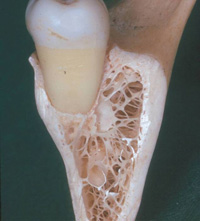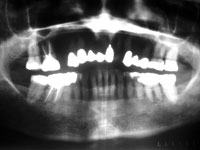In 1985 I found myself in a dental practice of my own making. However, it was not the practice I had imagined I would have. I was incredibly busy with little time to develop relationships with my patients and staff. The dentistry provided was always convenient, but not always what was the most appropriate for each individual patient.
The dental practice consumed most of my time and deeply affected family and personal relationships. How did I arrive at such a place? I had followed the common sense of others. I attracted as many patients as possible through insurance plans, print advertising, yellow page advertisements, catering to all groups, and providing all services and extended hours. I had become an “expert” by attending the hot weekend seminars. This approach led me to a practice that was out of control. Rather than feeling excitement for dentistry, I was tired.
That year I heard Dr. Harold Wirth speak at the Hinman Meeting about the uncommon dental practice that leads to an exciting practice life. I realized I would need to recreate my dental practice. To do this, I needed to look at my practice differently and use what could be considered uncommon sense.
Following Dr. Wirth’s suggestion, I attended The Pankey Institute’s Continuum Level One, which is focused on the complete evaluation of each patient. When I implemented complete evaluations in my practice, there was a ripple effect throughout all areas, and my previous common sense approach no longer applied. Some of the affected areas were treatment planning, treatment complexity, education, scheduling, personnel, referrals, practice growth, office environment, insurance philosophy, and financial arrangements.
 |
|
Illustration by: Brian Green
|
UNCOMMON SENSE ABOUT NEW PATIENTS
Have you heard the story about a panda that walks into a restaurant and has dinner? After finishing he gets up, takes a pistol, fires it into the ceiling, and begins to walk out. The alarmed waiter shouts, “Hold it! What was that all about?” The panda turns and throws him a dictionary. “I’m a panda! Look it up!” Opening the dictionary, the waiter reads, “Panda: an animal that eats, shoots, and leaves.” Commas can be quite important.
Unless you have a pediatric practice, you likely see very few new patients a month. By this, I mean “actually new” patients. The vast majority of our “new” patients have been patients somewhere else. Therefore, we do not provide new-patient experiences but rather new, patient experiences. The comma is important.
What are you providing your patients that has meaning for them as individuals and allows them to make intelligent, informed decisions concerning their present and future dental health? Glossy brochures, a dental “spa” experience, and other external patient perks will not create a meaningful relationship. A meaningful relationship with our patients is the keystone to the practice many of us envision, and it is frequently lacking in today’s common sense dental offices.
Today’s dentist should be uncommonly thorough, as many of us were initially trained in dental school. I believe it is our responsibility to provide our patients our best comprehensive evaluation, including a preclinical interview with the patient to discuss the patient’s previous dental experiences, current chief concerns, and longer-term health and aesthetic objectives. I always include radiographic and other appropriate imaging, multiple sets of diagnostic study casts that are face-bow mounted on a semiadjustable articulator, digital photographs, and an aesthetic evaluation
This new, patient experience should be positive, unique, valuable, and memorable. We must allow for nonpatient time for a diagnostic work-up and to develop an appropriate treatment plan that takes into account the patient’s immediate concerns, intermediate objectives, and long-range goals. You can plan to do the treatment in stages, based on sound dental principles, and not compromise the best long-lasting results for each individual.
UNCOMMON SENSE ABOUT BRANDING
Brands are powerful and have associated emotions. Just think of Mercedes-Benz, Porsche, Volvo, GM, Coca-Cola, Pepsi, Nike, and UPS. What is your practice brand? Does it represent the style of practice you desire? Too often, more time is spent on designing a logo than defining what the dental practice is really about.
Rather than delegate your branding to an ad agency, take the uncommon approach. Spend significant time thinking about the practice you would like to have. Envision what you would be doing most of the time, how you would be treated, how you would treat others, and what systems should be in place to support this vision. Then, gather your staff together away from the office to discuss what the practice should become. With your co-workers, develop a clear vision of your present brand and what you want your brand to be before hiring someone to design a logo, office sign, or advertising. Ask what you, your co-workers, and your patients think of when they think of your dental practice? Do your thoughts match? What changes can be made to have them become more congruent? Don’t stop there! Make changes to become the brand you envision.
A bustling dental practice reminds me of the iron ore carriers I worked on in my youth. Once under full power, even with full reverse it takes 14 miles to stop a heavily laden freighter. The momentum of a dental practice is much the same. Despite this, I made the decision to change. You can, too.
Uncommon Sense about Co-Workers
The common dental vernacular for the staff has become “the dental team.” Much of this is related to Dr. W. Edwards Deming’s 14 points of business philosophy that corporations and dental consultants embraced decades ago. All over the country, every morning, dental teams are huddling. Is it working?
The average annual dental employee turnover per office hovers around 25%. What are the reasons for this disruptive and costly turnover? I believe dental employees have not been encouraged to look at dentistry as a career. Managing groups of people is a monumental task, and I think it is time to look at our dental co-workers in an uncommon way. The dental team analogy may not be appropriate for the modern, relationship-based dental practice. Teams connote competition. Who are we competing against? Mr. Tooth Decay…other dentists?
With the amount of dentistry that is needed and wanted inside and outside of our dental offices, there is no reason to compete with our colleagues. If anything, it is a time to raise the bar and lift the profession to the highest standards of care. Evidence-based dental research should guide our dental treatment decisions, and appropriate treatment in our patients’ best interest should be the basis for our treatment plans.
Teams need a coach or manager along with frequent directions. They need a game plan and pep talks. From my experience, this becomes very tiring for everyone involved. Relatively speaking, teams have rather short-term goals:
the Super Bowl, the gold medal, and the national championship. And if you have noticed, they change players frequently, and the “team” looks different year after year.
I prefer to work with my co-workers like a string en-semble. Professional musicians are gifted in their own area of music, and many play multiple instruments. They work on their skills individually, and as a group when they rehearse. They do not need a conductor to begin their performance, and they take cues from each other. They make beautiful music together and help each other stay on key. They are nonjudgmental and want to engage their audience. They ask to be compensated fairly, and above all, they desire recognition for their efforts. In an ensemble, everyone is responsible for creating a memorable and meaningful individual and group experience.
UNCOMMON SENSE ABOUT FEES
Nothing seems to perk up dentists’ ears more than a discussion of dental fees. Dentists arrive at fees in some very interesting ways. Commonly they base them on the fees of other dentists in their area, a national dental organization’s geographical survey of fees, a formula related to their lab fee, an insurance reimbursement or what insurance allows, a per-unit price or per-service choice (charge per procedure), or a practice tradition adjusted on some time interval. Many dentists use a combination of these to determine their fees.
If you think about it, basing your fees on hearsay, lab fees, capitation, or the insurance-prescribed “usual and customary” makes about as much sense as attempting to diagnose and provide a fee estimate for a patient you have never examined. Do these fees have anything to do with the complexity of the individual patient’s treatment plan?
In dental school, we had to achieve so many crowns, so many extractions, and so many root canals. When we went into practice, it was quite easy to transfer this mindset to running a business. The ever-present insurance company was helpful in perpetuating this piecework-manufacturing model. But is this popular model congruent with arriving at the appropriate fee for each individual case?
Uncommon sense is not about the most expedient or even easiest way of doing things. It is pursuing the best and most appropriate treatment regardless of self, insurance company, or tradition. By thoroughly knowing your patient and the patient’s circumstances—both dental and nondental—we are in the best position to make the correct diagnosis and at the same time develop a fair fee for all those involved. Fees should compensate you for the care and time you take to study and develop a well-thought-out treatment plan for the most appropriate, individualized treatment. This includes the time you take to understand and evaluate—with care, skill, and judgment—the complexity of the case and the circumstances, temperament, and objectives of the patient.
I remember when my practice had a carefully typed fee sheet covered in plastic in the front desk drawer. The plastic was necessary because the sheet was dragged out for every patient. The receptionist would add up the numbers like they were items on a menu. Very convenient, very structured, and very unchangeable until I thought it was time for a fee adjustment. Now we have computers. We can enter our fees and have them ready to select and record at the end of the appointment. Even though we can change them much easier, do we? And if we do, why do we?
Would you approach a builder and say, “I would like you to build a custom house. How much will it be?” Is this any different than the inevitable question you hear at your local dental meeting, “How much do you charge for a crown?” We are curious about what others report, even though we know there is a vast difference in the care, skill, and judgment needed among patients, among quadrants, and among individual teeth.
When you want an estimate for building a house, the architect learns of your individual needs and wants. You both learn about each other’s philosophies of home design and what is expected of each other. The architect gathers information and takes notes on what information you present. Preliminary plans are drawn, and changes are made. Eventually a final set of plans are presented and explained to you. It is then and only then that the architect can give an accurate fee estimate based on time, complexity, and materials.
Many of us have gone through this in our lives. The point is that the architect generates a fee for the design work. Interestingly, the charge is in relation to the complexity of the project. When you utilize care, skill, and judgment in the diagnostic work-up, consult with specialists, and develop a treatment plan, do you realize that you are the architect of the case?
You are also the builder. Most builders separate the cost of materials (ie, lab costs) from the actual construction of the project. In fact, car mechanics and plumbers appreciate this separation. However, it is almost universal (common sense) for dentists to combine these costs into their dental fee. The uncommon determination of fees is to separate your care, skill, judgment, and the time allotted to determine a part of your fee from the additional appropriate fee for lab costs. With the ever-increasing use of implants in treatment plans, dentists are beginning to utilize this philosophy of fee determination. A fee discussion inevitably stimulates a debate on dental insurance (actually, benefits). That is a topic all its own that I look forward to presenting in the future.
Not to belabor the analogy, but don’t we have to maintain the house after it is built? We have no trouble charging our patients for hygiene maintenance. But it takes a little uncommon sense to ask what your time is worth to maintain the dentistry based on your individual circumstances, experience, unique training, care, skill, and judgment, not to mention the complexity of each individual case and the results anticipated.
UNCOMMON SENSE ABOUT RETIREMENT
Kaiser Wilhelm I lived from 1797 to 1888. His life spanned a time when the world was almost constantly at war. You may be surprised to know that he had a great influence on how many of us live our lives. In 1881 he assigned his chancellor, Otto von Bismarck (famous for battleships and jelly doughnuts) to create a first-of its-kind social program in Germany. It would be a pension provided by the government to help the elderly in their later years. At what age would it begin? Bismarck initially picked the age of 70 and later reduced it to 65. However, this reduction, although politically motivated, was not significant. When the program was implemented in 1884 the average lifespan of a German citizen was 47. The Kaiser held the purse strings very tightly.
When Franklin D. Roosevelt was designing this country’s Social Security plan, he merely used the German program as his template and adopted 65 as the age at which it would take effect. So common sense is to plan our retirements around the age of 65.
What does retirement mean to you? I have asked this question over many years to dental groups from all over the country. Invariably a common answer surfaces that can be recited almost word-for-word from group to group. “It’s doing what you want to do,” they say.
What does this have to do with 65? In fact, if retirement is doing what we want to do, what are our reasons for not “retiring” now? Just imagine if you have the practice life that you entirely enjoy, the time and financial means to spend time with family and friends, and the ability to “give back” to others in whatever way you wish. Isn’t that doing what you want to do? Look at your practice and your life in an uncommon way.
UNCOMMON SENSE ABOUT HAPPINESS
John Locke was a well-respected British philosopher who had a significant influence on the Founding Fathers of our country. He lived at the time of the Enlightenment, and the emerging focus of philosophy was on the rights of the individual. John Locke wrote about “life, liberty, and property.” Until Thomas Jefferson penned “life, liberty and the pursuit of happiness” in the Declaration of Independence, it was common sense for many to accept their circumstances. After the Declaration, people began to look at life in an uncommon way. They were empowered to create new possibilities that allowed them to experience uncommon success and happiness.
What begins as uncommon sense many times becomes common sense over time. Here are some thoughts on the pursuit of happiness. Surround yourself with great people. Create an environment that you love, and attract the people who are looking for the same. Become the best that you can be, and consistently hold out for what is best for others.
Dr. Beirl enjoys a private, restorative practice in Seminole, Fla. He is a visiting faculty member at The Pankey Institute and is a Pankey Scholar. Through his coaching/consulting business, Coaching the Professions, he helps dentists create the practice life they envision. He can be reached at (727) 391-0269 or brianbeirldds@bbeirl.com.











